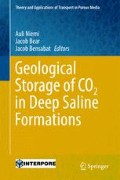Abstract
The objective of this first chapter is to give an overview of the role and status of Carbon Capture and Storage (CCS) technology in a world-wide perspective. The effects of increased greenhouse gas concentrations in the atmosphere, and their related impacts on climate change , are discussed first. This is followed by a discussion on options to mitigate the emissions and the role of CCS in these efforts, in terms of both the present status at the time of writing this book and future outlook.
Access this chapter
Tax calculation will be finalised at checkout
Purchases are for personal use only
References
CO2CRC (2011) A review of existing best practice manuals for carbon dioxide storage and regulation—a desktop study prepared for the Global CCS Institute by CO2CRC
European Council (2014) European Council (23 and 24 October 2014)—Conclusions, EUCO 169/14, Brussels, 24 Oct 2014
ETP (2012) Energy technology perspectives 2012—pathways to a clean energy system, 690 pp. ISBN: 978-92-64-17488-7, IEA (2012)
ETP (2014) Energy technology perspectives 2014—harnessing electricity’s potential, 380 pp. http://www.iea.org/publications/freepublications/publication/energy-technology-perspectives-2014.html. Accessed 26 Jun 2016
GEA (2012) Global energy assessment—toward a sustainable future. International Institute for Applied Systems Analysis, Vienna, Austria and Cambridge University Press, Cambridge, UK and New York, NY, USA
Global CCS Institute (2014) The global status of CCS: 2014, Melbourne, Australia
IEAGHG (2011a) Potential for biomass and carbon dioxide capture and storage. 2011/06, July, 2011
IEAGHG (2011b) Global storage resource gap analysis for policy makers. 2011/10, Sept, 2011
IEAGHG (2013a) Potential implications on gas production from shales and coals for geological storage of CO2. 2013/10, Aug, 2013
IEAGHG (2013b) The process of developing a CO2 test injection: experience and best practice. 2013/13, Dec, 2013
IEAGHG (2015) Carbon capture and storage cluster projects: review and future opportunities. 2015/03, Apr 2015
IGBP, IOC, SCOR (2013) Ocean acidification summary for policymakers—third symposium on the ocean in a high-CO2 World. International Geosphere-Biosphere Programme, Stockholm, Sweden
IPCC—Intergovernmental Panel on Climate Change (1988). http://www.ipcc.ch/organization/organization.shtml. Retrieved 28 Jun 2016
IPCC (1990) Climate change: the IPCC Scientific Assessment (1990) Report prepared for Intergovernmental Panel on Climate Change by Working Group I. In: Houghton JT, Jenkins GJ, Ephraums JJ (eds) Cambridge University Press, Cambridge, Great Britain, New York, NY, USA and Melbourne, Australia, 410 pp
IPCC (2005) IPCC Special Report on Carbon Dioxide Capture and Storage. In: Metz B, Davidson O, de Coninck, Loos M, Meyer LA (eds) Prepared by Working Group III of the Intergovernmental Panel on Climate Change. Cambridge University Press, Cambridge and NewYork, NY, 442 pp
IPCC (2007) Summary for policymakers. In: Climate change 2007: impacts, adaptation and vulnerability. In: Parry ML, Canziani OF, Palutikof JP, van der Linden PJ, Hanson CE (eds) Contribution of Working Group II to the Fourth Assessment Report of the Intergovernmental Panel on Climate Change. Cambridge University Press, Cambridge, 7–22
IPCC (2007) Summary for policymakers. In: Metz B, Davidson OR, Bosch PR, Dave R, Meyer LA (eds) Climate change 2007: mitigation. Contribution of Working Group III to the Fourth Assessment Report of the Intergovernmental Panel on Climate Change. Cambridge University Press, Cambridge and New York, NY
IPCC (2013) Summary for policymakers. In: Stocker TF, Qin D, Plattner G-K, Tignor M, Allen SK, Boschung J, Nauels A, Xia Y, Bex V, Midgley PM (eds) Climate change 2013: the physical science basis. Contribution of Working Group I to the Fifth Assessment Report of the Intergovernmental Panel on Climate Change. Cambridge University Press, Cambridge and New York, NY
IPCC (2014) Fifth Assessment Report (AR5). http://www.ipcc.ch/report/ar5/index.shtml. Accessed 28 Jun 2016
Le Treut H, Somerville R, Cubasch U, Ding Y, Mauritzen C, Mokssit A, Peterson T, Prather M (2007) Historical overview of climate change science. In: Solomon S, Qin D, Manning M, Chen Z, Marquis M, Averyt KB, Tignor M, Miller HL (eds) Climate change 2007: the physical science basis. Contribution of Working Group I to the Fourth Assessment Report of the Intergovernmental Panel on Climate Change. Cambridge University Press. Retrieved 14 Dec 2008
Monroe R (2013) What does 400 ppm look like? Original post at The Keeling Curve site. Available via Scripps Institution of Oceanography, UC San Diego https://scripps.ucsd.edu/programs/keelingcurve/. Accessed 28 Jun 2016
RCSP (2003) Regional carbon sequestration partnerships (RCSP) initiative. http://netl.doe.gov/research/coal/carbon-storage/carbon-storage-infrastructure/rcsp. Accessed 28 Jun 2016
Stern N (2007) The economics of climate change—the Stern review. Cambridge University Press, UK
Whittaker S, Perkins E (2013) Technical aspects of CO2 enhanced oil recovery and associated carbon storage. Global CCS Institute. http://www.globalccsinstitute.com/publications/technical-aspects-co2-enhanced-oil-recovery-and-associated-carbon-storage. Accessed 28 Jun 2016
Author information
Authors and Affiliations
Corresponding author
Editor information
Editors and Affiliations
Rights and permissions
Copyright information
© 2017 Springer Science+Business Media B.V.
About this chapter
Cite this chapter
Gale, J. (2017). CO2 Storage in Deep Geological Formations: The Concept. In: Niemi, A., Bear, J., Bensabat, J. (eds) Geological Storage of CO2 in Deep Saline Formations. Theory and Applications of Transport in Porous Media, vol 29. Springer, Dordrecht. https://doi.org/10.1007/978-94-024-0996-3_1
Download citation
DOI: https://doi.org/10.1007/978-94-024-0996-3_1
Published:
Publisher Name: Springer, Dordrecht
Print ISBN: 978-94-024-0994-9
Online ISBN: 978-94-024-0996-3
eBook Packages: Earth and Environmental ScienceEarth and Environmental Science (R0)

